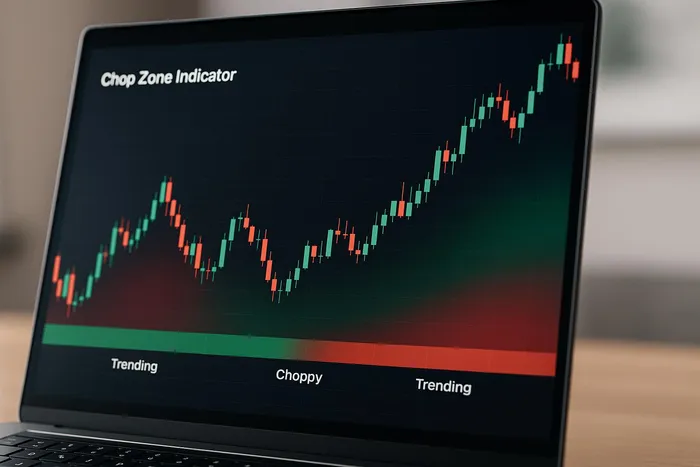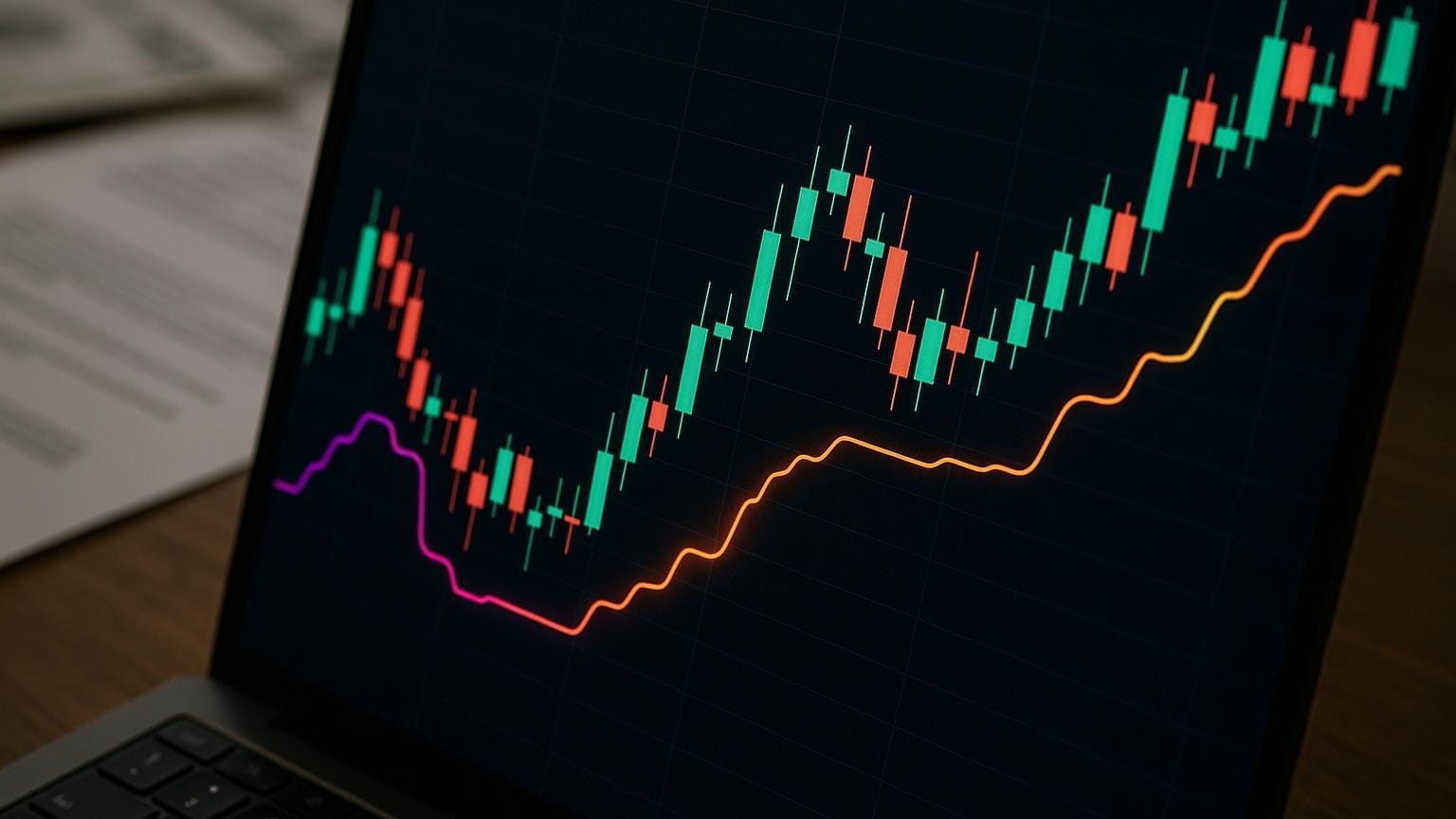Learn how the Chop Zone Indicator helps traders identify trending and choppy markets, enhancing decision-making and trading strategies.
The Chop Zone Indicator helps traders quickly identify whether a market is trending or stuck in sideways movement. It uses a color-coded histogram to visually display market phases:
- Green bars: Strong trending market, ideal for breakout or trend-following strategies.
- Red bars: Choppy, range-bound market, where false signals (often called whipsaws) are common, and caution is advised.
- Gray bars: Transitional phase, signaling uncertainty or trend loss.
Built on the Choppiness Index (CHOP), it evaluates volatility and directional movement over time. The indicator integrates seamlessly with LuxAlgo on TradingView, enhancing decision-making with features like multi-asset screening and AI Backtesting. While it excels at filtering out noise and identifying market phases, it’s best used alongside other technical tools like moving averages and RSI to confirm signals.
Key Takeaways:
- Use green bars for trend strategies, red for range-bound approaches, and gray for caution.
- Pair with other indicators for better precision.
- Adjust settings based on your market and timeframe.
This indicator simplifies market analysis, making it easier to align trading strategies with current conditions.
How the Chop Zone Indicator Works
Understanding the Calculation
The Chop Zone Indicator is built on the Choppiness Index (CHOP), which evaluates market volatility and directional movement over a set period. Essentially, it compares total volatility to the net price change within that timeframe.
Using a default 14-period lookback (which can be adjusted to match your trading style), the indicator calculates the sum of true ranges and compares it to the difference between the highest high and the lowest low. This ratio highlights how much of the price movement is directional versus random. For a refresher on how volatility interacts with trend-quality, see this overview of trend-following concepts.
In volatile but directionless markets, prices may swing wildly but end up close to their starting point. The Chop Zone Indicator captures this dynamic by translating the data into distinct color-coded zones.
To minimize false signals, the indicator applies logarithmic smoothing and uses percentage thresholds to define market states. Readings above 61.8% often signal choppy conditions, while values below 38.2% suggest a trending market. These thresholds are based on Fibonacci levels, providing clear boundaries for different phases of market behavior.
The result of this calculation is displayed as color-coded zones, which are explained in detail below.

The Color-Coded System Explained
The Chop Zone Indicator simplifies its complex calculations into an easy-to-read three-color histogram displayed below the price chart. Each color represents a specific market condition, helping traders quickly assess the trading environment.
- Green bars indicate strong trending conditions. These appear when the market moves decisively in one direction with minimal sideways activity. During these periods, breakout and trend-following strategies are often most effective. The shade of green may vary, with darker greens signaling stronger trends.
- Red bars highlight choppy, range-bound markets where prices lack clear direction. These conditions are marked by false breakouts, whipsaws, and sideways movement — often problematic for trend-following strategies. When red bars dominate, traders may prefer to wait for a clearer trend or switch to range-trading techniques.
- Gray (or neutral) bars represent transitional phases where the market isn’t strongly trending or entirely choppy. These zones often occur during consolidations or when trends begin to lose momentum. Caution is key here, as the market direction remains uncertain.
The histogram’s smooth color transitions and consecutive bars of the same color help confirm market conditions while filtering out short-term noise.
How to Read the Indicator on Charts
The histogram below the main chart provides a quick visual correlation between the indicator’s color changes and price movements. Here’s how to interpret it:
- Single bar signals give an immediate snapshot of the market’s current state. Green suggests trending, red signals choppiness, and gray indicates a transitional phase. However, the true power of the indicator lies in observing patterns over time.
- Color patterns reveal sustained market conditions. For instance, a series of green bars points to a prolonged trending phase, while alternating colors suggest instability or a market transition. Clusters of uniform colors provide more reliable signals.
- Multi-timeframe analysis enhances the indicator’s utility. For example, if the daily chart shows green trending bars but the 4-hour chart displays red choppy bars, this suggests a larger trend with short-term consolidation. Aligning your strategy with this broader context improves decision-making. For additional step-by-step guidance, see LuxAlgo’s primer on confirming entries with multi-timeframes.
The Chop Zone Indicator becomes even more effective when paired with price action analysis. For example, green bars during a breakout confirm the trend, while red bars during the same breakout might warn of a potential false move.
Pay close attention to color changes near key technical levels like support and resistance or moving averages. A shift from red to green near a support level can signal the start of a new trend. Conversely, a change from green to red after a prolonged trend might indicate the beginning of a consolidation phase.
Adding volume analysis can further validate the signals. Strong trending conditions (green bars) often coincide with above-average volume, while inconsistent volume during choppy phases (red bars) reflects market indecision. This combination of tools provides a more comprehensive view of market dynamics.
Using the Chop Zone Indicator in Trading
Identifying Trending vs. Choppy Market Conditions
The Chop Zone Indicator is a handy way to recognize whether the market is trending or stuck in a choppy phase, helping traders make more informed decisions. Red bars signal a choppy market, where prices tend to reverse frequently. This kind of environment is tough for trend-following strategies, as false breakouts and whipsaws can quickly eat into your trading account.
When red bars appear, it’s wise to either reduce your trade sizes or switch to range-bound strategies. If you’re unsure, it’s often better to step back and wait for clearer trends to emerge. This cautious approach can protect your capital from the unpredictable price swings that characterize choppy markets.
On the other hand, green bars indicate a strong trend, creating ideal conditions for breakout trades, trend continuations, and momentum-based strategies. A cluster of green bars suggests a more sustained trend rather than a temporary directional move, offering better opportunities for traders to capitalize.
Gray bars represent transitional phases. If you see gray bars following a series of green ones, it might mean the trend is losing steam. While this doesn’t guarantee an immediate reversal, it’s a good time to tighten your risk management and proceed with caution.
Combining with Other Technical Indicators
The Chop Zone Indicator works best when paired with other tools. Relying on it alone can lead to missed opportunities or missteps, so combining it with additional indicators can provide a clearer picture of the market.
- Moving Averages: These are excellent for confirming trends. For example, green bars paired with prices trading above the 50-day moving average reinforce the presence of an uptrend. Similarly, red bars often coincide with prices oscillating around moving averages, signaling sideways markets.
- Relative Strength Index (RSI): The RSI can help fine-tune entry and exit points. If green bars are present but the RSI is above 70 or below 30, it might hint at an upcoming pullback or consolidation despite the trend.
- LuxAlgo Price Action Concepts (PAC) Toolkit: Use PAC on TradingView to identify key support and resistance levels and market structure. When the Chop Zone shows green trending bars, PAC can highlight order blocks and breakout patterns that align with the trend. Explore more tools on the Features page.
- Volume Analysis: Trends backed by strong volume (green bars) are more likely to be genuine, showing institutional involvement. Meanwhile, inconsistent volume during red bars often points to weak moves that could reverse. For basics, see what trading volume indicates.
- Oscillator Matrix (OSC): This toolkit detects divergences in real time. If green bars begin transitioning to gray or red, divergences flagged by OSC can act as early warnings, helping you adjust positions before major reversals. See the docs on reversal signals.
Best Practices for Strategy Integration
To get the most out of the Chop Zone Indicator, it’s crucial to adapt your trading approach based on the market conditions it identifies. During green-bar periods, focus on breakout trades, trend-continuation setups, and momentum-based entries. These strategies thrive in trending markets.
Adjust your position sizes depending on the market phase. For example, during strong trends (green bars), you might consider increasing your position size within your risk limits. In contrast, during choppy conditions (red bars), it’s often better to scale back or avoid new trades entirely until the market provides clearer signals.
When entering trades, wait for consistent green bars to confirm trending conditions. Tighten your stops or prepare to exit if the indicator shifts to gray or red bars. This approach helps filter out premature entries, especially during transitional phases.
Using multi-timeframe analysis can add another layer of precision. For instance, if the daily chart shows green trending bars while the hourly chart shows red choppy conditions, it could signal temporary consolidation within a larger trend. This insight can help refine your timing for entries and exits.
Lastly, during choppy periods marked by red bars, apply tighter stop-losses and keep your holding periods short. For day traders, this might mean reducing the number of trades. For swing traders, it’s an opportunity to wait for longer-term trends marked by green bars before making a move. By aligning your strategy with the Chop Zone Indicator’s signals, you can navigate the market more effectively and manage risk with greater confidence. For idea testing across markets and timeframes, try LuxAlgo’s AI Backtesting.
Chop Zone Indicator on TradingView
Pros and Cons of the Chop Zone Indicator
Let’s dive into the strengths and weaknesses of the Chop Zone Indicator — a tool designed to help traders navigate the complexities of market movements.
Key Benefits
The Chop Zone Indicator brings several advantages to the table, making it useful for traders. Its color-coded design offers immediate visual feedback, helping traders quickly determine whether the market is trending or stuck in a choppy phase — no need for lengthy analysis[2][4]. This simplicity is a time-saver, especially in fast-moving markets.
Another standout feature is its ability to provide real-time insights into market conditions. By highlighting sideways, range-bound periods, the indicator helps traders avoid entering trades during unfavorable conditions and instead focus on trending opportunities[1][4]. This is especially helpful for day traders who rely on quick, informed decisions.
The indicator also excels at filtering out false signals in low-volatility environments. When it identifies choppy conditions through colors like gray or yellow, it signals traders to steer clear of breakout or trend-following strategies, reducing the chances of overtrading[1][2][4].
Its versatility is another plus. The Chop Zone Indicator works across various markets, including stocks, indices, commodities, and cryptocurrencies[1][4]. This makes it particularly handy for assets like the S&P 500, NASDAQ, forex pairs, and even Bitcoin, which often shift between trending and consolidating phases.
Potential Drawbacks
While the Chop Zone Indicator has its strengths, it’s not without flaws. One common issue is signal lag, which can delay reactions to market changes. This lag may lead to less-than-ideal trade entries or exits, particularly during rapid market shifts[3].
The tool can also produce ambiguous signals during fast transitions, which may confuse less experienced traders. And since the indicator doesn’t provide specific entry or exit signals, relying on it alone without additional tools can result in poor decisions[3][4]. To build a complete strategy, traders will need to pair it with other technical analysis tools.
Another drawback is the lack of academic validation. While traders often praise the indicator and backtesting results show promise, there’s limited formal research to quantify its effectiveness[1][3][4]. Most of its credibility comes from practical use and testimonials rather than rigorous studies.
Comparison Table: Pros and Cons
| Pros | Cons |
|---|---|
| Easy-to-read, color-coded visuals | Signal lag during market changes |
| Offers real-time market insights | Can produce unclear signals in fast transitions |
| Filters out false signals in choppy markets | Doesn’t provide entry/exit signals |
| Reduces overtrading risks | Needs support from other indicators |
| Works across multiple markets and assets | Limited formal research backing |
Conclusion and Key Takeaways
What the Chop Zone Indicator Brings to the Table
The Chop Zone Indicator acts as a visual guide for traders, helping them distinguish between trending and choppy market conditions. Its color-coded system makes this process straightforward: gray represents a transitional phase, green signals trending markets, and red highlights choppy conditions. This simplicity can help traders steer clear of a common mistake — overtrading in sideways markets, where profits are often elusive.
One of its standout features is its flexibility. Whether you're trading S&P 500 stocks, NASDAQ indices, forex pairs, or even Bitcoin, the Chop Zone Indicator adapts to different markets. By filtering out false signals, it helps traders avoid unnecessary losses and focus on preserving their capital.
While it doesn’t pinpoint exact entry or exit points, the Chop Zone Indicator shines when paired with other tools. Combining it with trend, momentum, and volatility indicators creates a more comprehensive analysis framework. Its real strength lies in helping traders understand the market’s current behavior, enabling them to fine-tune their strategies.
Practical Tips for Using the Chop Zone Indicator Effectively
To get the most out of the Chop Zone Indicator, keep these tips in mind:
- Confirm signals with other tools: For example, if the indicator transitions from gray (choppy) to green (trending up), use additional confirmation, such as a moving-average crossover or RSI momentum, before taking action. This reduces the chances of falling for false breakouts.
- Adjust settings for your market and timeframe: The optimal setup for daily S&P 500 charts might not work for short-term cryptocurrency trades. Regularly tweak the indicator to align with your specific trading style and asset class. If you’re new to LuxAlgo, the documentation library offers quick starts and feature guides.
- Leverage LuxAlgo’s features for better results: Pairing the Chop Zone Indicator with resources like AI Backtesting Assistant can help you test various strategies and refine them based on historical data.
Ultimately, while the Chop Zone Indicator is powerful, its success depends on disciplined risk management and confirming signals with other technical analyses.
FAQs
How can I use the Chop Zone Indicator with other tools to improve my trading strategy?
To get the most out of the Chop Zone Indicator, consider pairing it with other technical tools like the Relative Strength Index (RSI), Moving Averages, or Bollinger Bands. These tools can help confirm trends or detect sideways markets, giving you a clearer picture of current market conditions.
For instance, combining the Chop Zone Indicator with volume analysis or trend lines can refine signal accuracy. This approach helps you distinguish between trending and ranging markets, enabling you to make better-informed decisions. Such combinations are especially useful during periods of high volatility or when the market becomes unpredictable.
What are the risks of using only the Chop Zone Indicator for market analysis?
Relying entirely on the Chop Zone Indicator for market analysis can be risky. During periods of low volatility or when prices move sideways, it might produce misleading signals. This could cause traders to misread the market, confusing erratic movements with the start of a new trend.
Another limitation is that the indicator doesn’t account for fundamental factors or broader market dynamics. Overlooking these critical elements can lead to unexpected losses, particularly during sharp market reversals or major news events. To navigate the markets more effectively, it’s wise to pair the Chop Zone Indicator with other analytical tools and market insights. This approach provides a more balanced and informed trading strategy.
How can I customize the Chop Zone Indicator for different markets and timeframes?
To customize the Chop Zone Indicator for different markets and timeframes, you can tweak settings such as the ATR length and CPMA length. These parameters influence how the indicator distinguishes between choppy and trending market conditions, enabling you to match it to the volatility and timeframe of your trading approach.
Adjusting these settings allows you to adapt the indicator for both short-term and long-term trading. This can improve your ability to interpret market behavior and make informed decisions. Test various configurations to discover the setup that aligns best with your trading style and the conditions of the market you're analyzing.
References
LuxAlgo Resources
- Trending Market Toolkit
- LuxAlgo Homepage
- New AI Backtesting Features for Smarter Trading
- Understanding Moving Averages and How Traders Use Them
- AI Backtesting: Fetching Strategies
- Breakouts with Tests & Retests
- Range Detector
- Multi-Timeframe Market Formation
- Breakout Detector (Previous MTF High/Low Levels)
- LuxAlgo Features
- AI Backtesting Assistant — Complete Breakdown
- Oscillator Matrix: Reversal Signals
- AI Backtesting (Main Page)
- LuxAlgo Documentation Library
- 5 Steps to Confirm Entries with Multi-Timeframes
External Resources
- Choppiness Index (TradingView Support)
- Whipsaw Explained (Investopedia)
- Trend-Following Overview (Investopedia)
- Support and Resistance (Investopedia)
- RSI Guide (Fidelity)
- Bollinger Bands (Wikipedia)
- What Trading Volume Indicates (Investopedia)
- TradingView
- Angel One: Chop Zone Indicator
- Binance Square: Chop Zone
- FXOpen: Chop Zone Indicator
- Ventura Securities: Chop Zone Indicator








